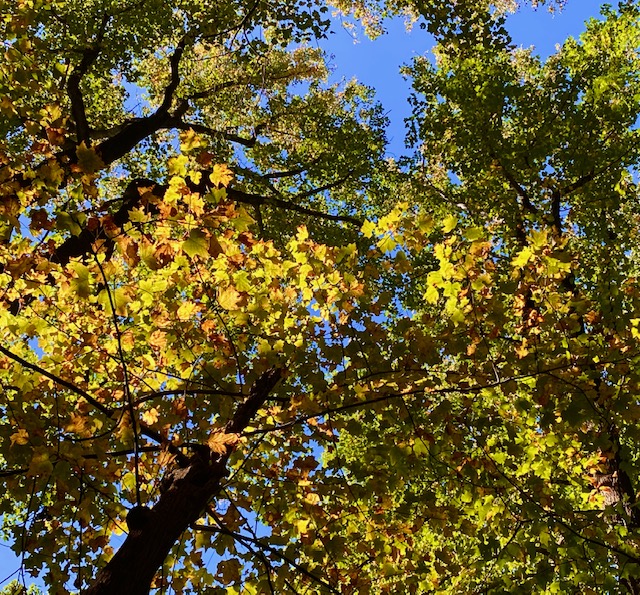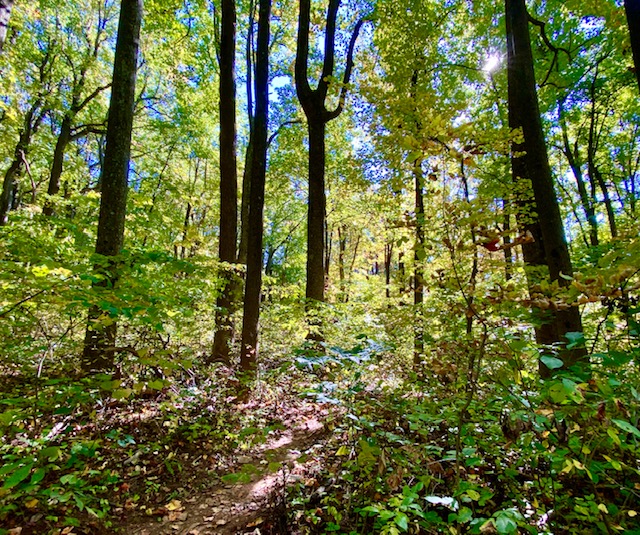By Glynn Wilson –
SHENANDOAH NATIONAL PARK, Va. — Warm, humid October weather that could be attributed to climate change due to global warming from humans burning fossil fuels for energy has slowed the arrival of peak Autumn color in the mountains of Virginia.
But it was a beautiful day in the park anyway on Wednesday, Oct. 20. You can’t go wrong getting outside and enjoying a national park on a day like this with temperatures in the low 70s and not a cloud in the baby blue sky.
Take the time to sit on a rock wall at one of the many overlooks along Skyline Drive and thank those who were smart enough nearly a century ago who saw the need and benefit to preserve this wild and scenic land from private developers for wildlife and future generations.
According research complied by the National Park Service, the first traces of humans within Shenandoah National Park are around 8,000 to 9,000 years old. Native Americans seasonally visited this area to hunt, gather food, source materials for stone tools, and trade.
In the 1700s, European hunters and trappers explored the mountains of the Blue Ridge and Shenandoah Valley. Soon after 1750, European settlers moved into the lower hollows near springs and streams. Over the next century and a half hundreds of families worked the land, planting orchards and crops, building homesteads and mills, using the mountains for logging and mining.
By the late 1800s an increasingly urban American society yearned for places of recreation and refuge. Enterprising spirits built vacation resorts, marketing the mountain views, healthy water, and cool breezes. As congress established National Parks in the west, a call arose for an eastern National Park accessible to large population centers. It would take two decades to authorize Shenandoah National Park. Another decade passed before the park’s establishment.
Learning about the history of Shenandoah means learning about the lives and communities of past mountain residents, the establishment of the Park, the Civilian Conservation Corps, segregation of early park visitors, the dynamic shifting role of parks in our society, and much more. All of these subjects have a lasting impact on what Shenandoah is today and what it may become in the future.
I’ve been visiting, exploring, photographing and writing about Shenandoah for the past eight years, since I first moved to the D.C. area in a media camper van. See the links below the photographs to check out a few of our most important stories.
More Photos
This is what peak color looks like looking north from Black Bear Curve along Skyline Drive:
More Stories from Shenandoah
Climate Change Comes to Shenandoah
Shenandoah’s Lewis Mountain Campground Welcomed African Americans
Camping and Hiking in Shenandoah National Park in Virginia
Autumn Color 2020: Shenandoah National Park, Virginia
Herbert Hoover’s Camp Rapidan Tour, Shenandoah National Park
Yearling Bear Named ‘Boo Boo’ Chooses Awkward Glade at Big Meadows in Shenandoah National Park
Secret Vistas: A Spiritual Experience in Shenandoah
___
If you support truth in reporting with no paywall, and fearless writing with no popup ads or sponsored content, consider making a contribution today with GoFundMe or Patreon or PayPal.
Before you continue, I’d like to ask if you could support our independent journalism as we head into one of the most critical news periods of our time in 2024.
The New American Journal is deeply dedicated to uncovering the escalating threats to our democracy and holding those in power accountable. With a turbulent presidential race and the possibility of an even more extreme Trump presidency on the horizon, the need for independent, credible journalism that emphasizes the importance of the upcoming election for our nation and planet has never been greater.
However, a small group of billionaire owners control a significant portion of the information that reaches the public. We are different. We don’t have a billionaire owner or shareholders. Our journalism is created to serve the public interest, not to generate profit. Unlike much of the U.S. media, which often falls into the trap of false equivalence in the name of neutrality, we strive to highlight the lies of powerful individuals and institutions, showing how misinformation and demagoguery can harm democracy.
Our journalists provide context, investigate, and bring to light the critical stories of our time, from election integrity threats to the worsening climate crisis and complex international conflicts. As a news organization with a strong voice, we offer a unique, outsider perspective that is often missing in American media.
Thanks to our unique reader-supported model, you can access the New American journal without encountering a paywall. This is possible because of readers like you. Your support keeps us independent, free from external influences, and accessible to everyone, regardless of their ability to pay for news.
Please help if you can.
American journalists need your help more than ever as forces amass against the free press and democracy itself. We must not let the crypto-fascists and the AI bots take over.
See the latest GoFundMe campaign here.
Don't forget to listen to the new song and video.
Just because we are not featured on cable TV news talk shows, or TikTok videos, does not mean we are not getting out there in search engines and social media sites. We consistently get over a million hits a month.
Click to Advertise Here






















